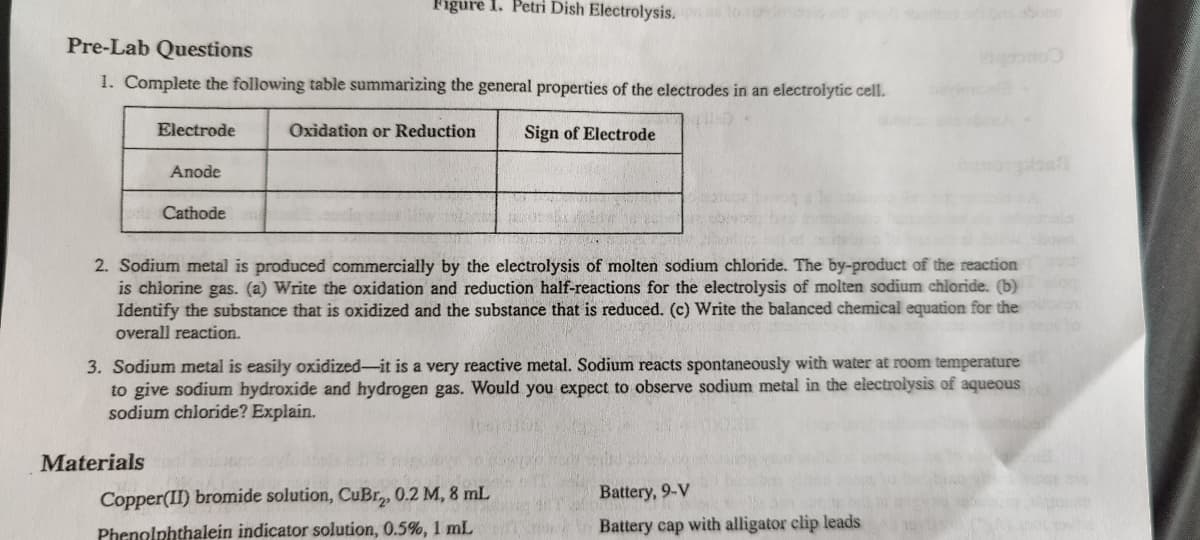2. Sodium metal is produced commercially by the electrolysis of molten sodium chloride. The by-product of the reaction is chiorine gas. (a) Write the oxidation and reduction half-reactions for the electrolysis of molten sodium chloride. (b) Identify the substance that is oxidized and the substance that is reduced. (c) Write the balanced chemical equation for the overall reaction.
2. Sodium metal is produced commercially by the electrolysis of molten sodium chloride. The by-product of the reaction is chiorine gas. (a) Write the oxidation and reduction half-reactions for the electrolysis of molten sodium chloride. (b) Identify the substance that is oxidized and the substance that is reduced. (c) Write the balanced chemical equation for the overall reaction.
Chemical Principles in the Laboratory
11th Edition
ISBN:9781305264434
Author:Emil Slowinski, Wayne C. Wolsey, Robert Rossi
Publisher:Emil Slowinski, Wayne C. Wolsey, Robert Rossi
Chapter32: Voltaic Cell Measurements
Section: Chapter Questions
Problem 2ASA
Related questions
Question
2)

Transcribed Image Text:Figure 1. Petri Dish Electrolysis. to
sboon
Pre-Lab Questions
1. Complete the following table summarizing the general properties of the electrodes in an electrolytic cell.
Electrode
Oxidation or Reduction
Sign of Electrode
Anode
Cathode
2. Sodium metal is produced commercially by the electrolysis of molten sodium chloride. The by-product of the reaction
is chiorine gas. (a) Write the oxidation and reduction half-reactions for the electrolysis of molten sodium chloride. (b)
Identify the substance that is oxidized and the substance that is reduced. (c) Write the balanced chemical equation for the
overall reaction.
3. Sodium metal is easily oxidized-it is a very reactive metal. Sodium reacts spontaneously with water at room temperature
to give sodium hydroxide and hydrogen gas. Would you expect to observe sodium metal in the electrolysis of aqueous
sodium chloride? Explain.
Materials
Copper(II) bromide solution, CuBr,, 0.2 M, 8 mL
Battery, 9-V
Phenolphthalein indicator solution, 0.5%, 1 mL
Battery cap with alligator clip leads
Expert Solution
This question has been solved!
Explore an expertly crafted, step-by-step solution for a thorough understanding of key concepts.
This is a popular solution!
Trending now
This is a popular solution!
Step by step
Solved in 2 steps

Knowledge Booster
Learn more about
Need a deep-dive on the concept behind this application? Look no further. Learn more about this topic, chemistry and related others by exploring similar questions and additional content below.Recommended textbooks for you

Chemical Principles in the Laboratory
Chemistry
ISBN:
9781305264434
Author:
Emil Slowinski, Wayne C. Wolsey, Robert Rossi
Publisher:
Brooks Cole

Chemistry by OpenStax (2015-05-04)
Chemistry
ISBN:
9781938168390
Author:
Klaus Theopold, Richard H Langley, Paul Flowers, William R. Robinson, Mark Blaser
Publisher:
OpenStax

Principles of Modern Chemistry
Chemistry
ISBN:
9781305079113
Author:
David W. Oxtoby, H. Pat Gillis, Laurie J. Butler
Publisher:
Cengage Learning

Chemical Principles in the Laboratory
Chemistry
ISBN:
9781305264434
Author:
Emil Slowinski, Wayne C. Wolsey, Robert Rossi
Publisher:
Brooks Cole

Chemistry by OpenStax (2015-05-04)
Chemistry
ISBN:
9781938168390
Author:
Klaus Theopold, Richard H Langley, Paul Flowers, William R. Robinson, Mark Blaser
Publisher:
OpenStax

Principles of Modern Chemistry
Chemistry
ISBN:
9781305079113
Author:
David W. Oxtoby, H. Pat Gillis, Laurie J. Butler
Publisher:
Cengage Learning

Chemistry: An Atoms First Approach
Chemistry
ISBN:
9781305079243
Author:
Steven S. Zumdahl, Susan A. Zumdahl
Publisher:
Cengage Learning

Chemistry
Chemistry
ISBN:
9781305957404
Author:
Steven S. Zumdahl, Susan A. Zumdahl, Donald J. DeCoste
Publisher:
Cengage Learning
